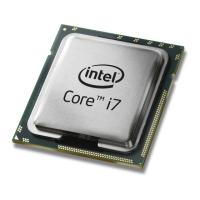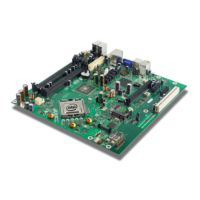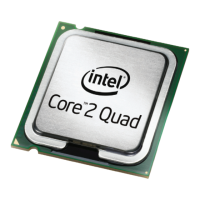Datasheet, Volume 1 43
Technologies
3.6.1 PCLMULQDQ Instruction
The processor supports the carry-less multiplication instruction, PCLMULQDQ.
PCLMULQDQ is a Single Instruction Multiple Data (SIMD) instruction that computes the
128-bit carry-less multiplication of two, 64-bit operands without generating and
propagating carries. Carry-less multiplication is an essential processing component of
several cryptographic systems and standards. Hence, accelerating carry-less
multiplication can significantly contribute to achieving high speed secure computing
and communication.
3.7 Intel
®
64 Architecture x2APIC
The x2APIC architecture extends the xAPIC architecture that provides a key mechanism
for interrupt delivery. This extension is intended primarily to increase processor
addressability.
Specifically, x2APIC:
• Retains all key elements of compatibility to the xAPIC architecture
— delivery modes
— interrupt and processor priorities
— interrupt sources
— interrupt destination types
• Provides extensions to scale processor addressability for both the logical and
physical destination modes
• Adds new features to enhance performance of interrupt delivery
• Reduces complexity of logical destination mode interrupt delivery on link based
architectures
The key enhancements provided by the x2APIC architecture over xAPIC are the
following:
• Support for two modes of operation to provide backward compatibility and
extensibility for future platform innovations
— In xAPIC compatibility mode, APIC registers are accessed through a memory
mapped interface to a 4
KB page, identical to the xAPIC architecture.
— In x2APIC mode, APIC registers are accessed through Model Specific Register
(MSR) interfaces. In this mode, the x2APIC architecture provides significantly
increased processor addressability and some enhancements on interrupt
delivery.
• Increased range of processor addressability in x2APIC mode
— Physical xAPIC ID field increases from 8 bits to 32 bits, allowing for interrupt
processor addressability up to 4G-1 processors in physical destination mode. A
processor implementation of x2APIC architecture can support fewer than 32-
bits in a software transparent fashion.
— Logical xAPIC ID field increases from 8 bits to 32 bits. The 32-bit logical x2APIC
ID is partitioned into two sub-fields—a 16-bit cluster ID and a 16-bit logical ID
within the cluster. Consequently, ((2^20) -16) processors can be addressed in
logical destination mode. Processor implementations can support fewer than
16
bits in the cluster ID sub-field and logical ID sub-field in a software agnostic
fashion.

